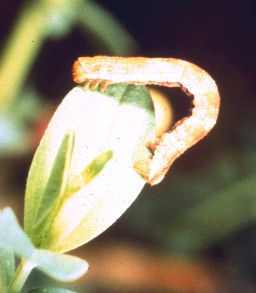- Aplocera plagiata
(Lepidoptera: Geometridae)
Insect Links Eggs Larva/Adult Pupa Defoliation
 Origin:
Europe.
Origin:
Europe.
Life Cycle:
Over wintering Stage: As a partly grown larva found in the soil
litter around the plant. (1)
Egg Stage: A female Aplocera plagiata can lay 300 eggs in a life time. They are laid in small groups on the flowers and leaves of St. Johnswort. (2) The eggs are pearly white, oval in appearance and take 5-7 days to hatch. (1)
Larval stage: As a larva, Aplocera plagiata is a
reddish brown inch worm that may mimic a dead twig. (2) The larva's
main purpose is to defoliate the St. Johnswort. The larva can feed
in the sunlight, and it's cuticle filters out 80% of the 550 NM light band
1. (1) The most mature larva burrows into the soil during the day.
(1) In the moist soil it is prone to fungus infection. (2) The fall
generation feeds on the flowers, but when winter comes it goes into the
soil. (1)
Pupil stage: When the Aplocera plagiata pupate
they are slender and a light greenish-golden brown. (2) They may
pupate around the soil litter or under the soil. (2) The pupation
stage can last 15-17 days. (2)
Adult Stage: The second generation of the year is greater
in numbers than the first. (2) The weather in the winter may determine
this. (2) The adults are a delta shaped moth with dark bands
streaking across the wings of the moth. (2)
Type of Damage to Host: Aplocera plagiata
defoliates St. Johnswort as a larva. (2)
Stage/plant species: The larva defoliates the St. Johnswort leaves, flowers and tender shoots.
Location: Aplocera plagiata can be released around rocky, dry, open sand limestone regions where St. Johnswort is abundant. (2)
Host Impact (Method/Focus): Aplocera plagiata can be very effective in some areas. It mainly defoliates the leaves and flowers of the plant.
Favorable/unfavorable release areas. It's favorable release location would be around rocky, dry, open sand limestone regions where St. Johnswort is abundant. (2)
How and where to collect, Transport and Release: Aplocera plagiata may be collected as larva by hand picking and with a sweep net. They should be kept cool while in storage for several days before being redistributed. In transit, they should be kept cool by placing in a cooler with an ice pack in a paper or styrofoam container. (2)
How to Redistribute once established: Should be distributed on dry sandy areas where limestone is adequate. (2) The larva should be well distrusted, one or two per plant over a large area. Over 100 would be a good release size. (1)
Where and how to Purchase: Aplocera plagiata
can be purchased in September at Biological control of Weeds Inc., 1418
Maple Drive, Bozeman, MT 59715: Phone: 406-586-5111 Fax:
406-586-1679. (5)
Bibliography:
1. Harris. P. Aplocera plagiata (L.). Defoliation Moth, [online available] http://res.agr.ca/leth/weed/bio/aplocera.htm , O7-13-99.
2. Rees, Norman, et. al., Ed., Biological Control of Weeds in the
West, Western Society of Weed Science, in Cooperation with USDA ARS,
MT Dept. of Ag, and MT State Univ., Color Printers, Bozeman, MT, Feb.,
1996.
3. Breitenfeldt, Todd, Personal Interview about Aplocera plagiata:
Biology, Teacher, Whitehall High School, P.O. Box 1109, Whitehall, MT 59759,
(406)287-5403, Sept., 1999.
4 Author of article: Jane Drueger: Title of article: St. Johns Wort: III and Cure? Location: Montana University Communications Services [Online available] http://www.montan.edu/wwwpb/ag/st.html .
5. Title of Co. : Biological Control of Weed Inc., Name of Article:
St. Johnswort Insects, last update unavailable. http://www.bio-control.com/7d.html
, Can be located at: Biological control of weeds, Inc. 1418 Maple Drive,
Bozeman, MT 59715, Phone: 406-586-5111, Fax: 406-586-1679.
Written and Published by: Joe Perigo
Back mtwow.org HOME